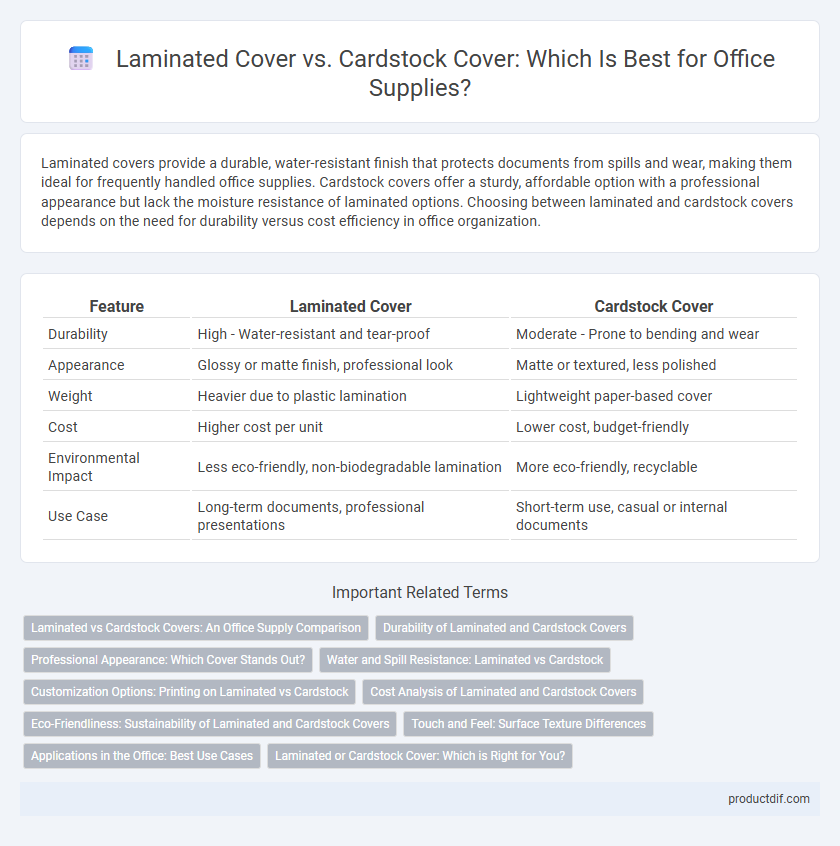Laminated covers provide a durable, water-resistant finish that protects documents from spills and wear, making them ideal for frequently handled office supplies. Cardstock covers offer a sturdy, affordable option with a professional appearance but lack the moisture resistance of laminated options. Choosing between laminated and cardstock covers depends on the need for durability versus cost efficiency in office organization.
Table of Comparison
| Feature | Laminated Cover | Cardstock Cover |
|---|---|---|
| Durability | High - Water-resistant and tear-proof | Moderate - Prone to bending and wear |
| Appearance | Glossy or matte finish, professional look | Matte or textured, less polished |
| Weight | Heavier due to plastic lamination | Lightweight paper-based cover |
| Cost | Higher cost per unit | Lower cost, budget-friendly |
| Environmental Impact | Less eco-friendly, non-biodegradable lamination | More eco-friendly, recyclable |
| Use Case | Long-term documents, professional presentations | Short-term use, casual or internal documents |
Laminated vs Cardstock Covers: An Office Supply Comparison
Laminated covers provide enhanced durability and water resistance compared to cardstock covers, making them ideal for frequently handled documents and presentations. Cardstock covers offer a cost-effective and customizable option with a variety of colors and finishes but lack the protective qualities of lamination. Choosing between laminated and cardstock covers depends on the need for longevity and professional appearance versus budget-friendly, versatile options in office supply.
Durability of Laminated and Cardstock Covers
Laminated covers provide superior durability by adding a protective plastic layer that resists water, stains, and tearing, extending the lifespan of documents. Cardstock covers, while thicker and sturdier than regular paper, lack the moisture resistance and scratch protection of lamination, making them more susceptible to wear in high-traffic environments. For long-term use or frequent handling, laminated covers outmatch cardstock covers by maintaining structural integrity and appearance over time.
Professional Appearance: Which Cover Stands Out?
Laminated covers provide a glossy, durable finish that resists wear and moisture, enhancing the professional appearance of presentations and reports. Cardstock covers offer a sturdy, textured surface with a matte finish that conveys a classic, sophisticated look while maintaining rigidity. For projects requiring a polished and long-lasting impression, laminated covers stand out, especially in high-traffic or client-facing environments.
Water and Spill Resistance: Laminated vs Cardstock
Laminated covers provide superior water and spill resistance compared to cardstock covers, making them ideal for environments prone to moisture or frequent handling. The plastic coating on laminated covers prevents liquids from seeping in, protecting documents from damage and maintaining durability. In contrast, cardstock covers absorb spills more readily, leading to potential warping, staining, and reduced longevity.
Customization Options: Printing on Laminated vs Cardstock
Laminated covers offer exceptional durability and a sleek finish, making them ideal for high-quality custom printing with vibrant colors and detailed graphics that resist wear and tear. Cardstock covers provide a versatile surface suitable for diverse printing methods, including embossing and foil stamping, allowing for textured, tactile designs with customizable thicknesses. Printing on laminated covers ensures long-lasting protection for intricate designs, while cardstock printing emphasizes creative flexibility and a premium, handcrafted appearance.
Cost Analysis of Laminated and Cardstock Covers
Laminated covers typically cost 20-30% more than cardstock covers due to the additional materials and manufacturing processes involved in lamination. While cardstock covers are more affordable and suitable for short-term use, laminated covers provide greater durability and protection, potentially reducing replacement expenses in the long run. Businesses must weigh the upfront cost against the extended lifespan and professional appearance that laminated covers offer when budgeting for office supplies.
Eco-Friendliness: Sustainability of Laminated and Cardstock Covers
Laminated covers, often made from plastic materials, provide durability but have a higher environmental impact due to limited recyclability and longer degradation times. Cardstock covers, composed of thick paper, are more eco-friendly as they are biodegradable and typically recyclable, supporting sustainable office practices. Choosing cardstock over laminated covers reduces waste and promotes a smaller carbon footprint in office supply usage.
Touch and Feel: Surface Texture Differences
Laminated covers offer a smooth, glossy finish that enhances durability and provides a sleek, professional feel, making documents resistant to moisture and wear. Cardstock covers feature a textured, matte surface that delivers a natural, tactile grip, appealing to those who prefer a more traditional, paper-like sensation. The choice between laminated and cardstock covers depends on whether a shiny, robust touch or a soft, textured feel best suits the document's purpose and user experience.
Applications in the Office: Best Use Cases
Laminated covers excel in office applications requiring durability and moisture resistance, making them ideal for frequently handled documents such as presentations, reports, and training manuals. Cardstock covers provide a cost-effective, professional appearance suitable for temporary materials like meeting agendas, project proposals, and internal memos. Selecting laminated or cardstock covers depends on the balance between longevity needs and budget constraints within office environments.
Laminated or Cardstock Cover: Which is Right for You?
Laminated covers provide superior durability and water resistance, making them ideal for frequently handled documents or presentations that require a professional finish. Cardstock covers offer a cost-effective, sturdy option with a matte or glossy finish suitable for short-term use or less exposed materials. Choosing between laminated and cardstock covers depends on your need for protection, appearance, and budget for office supplies.
Laminated cover vs Cardstock cover Infographic

 productdif.com
productdif.com